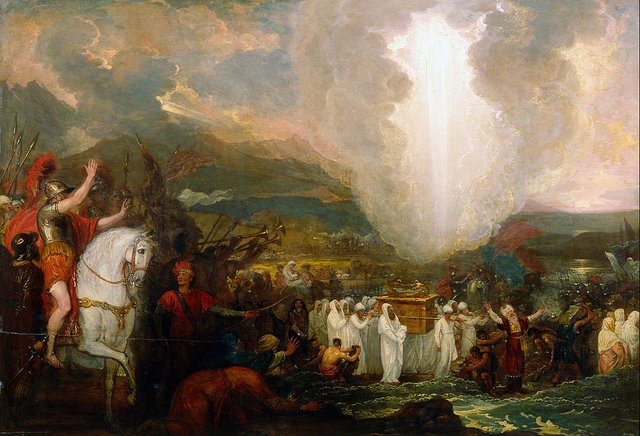
In the preceding article in this series, we saw how Joshua dispatched two men from his camp in Shittim to cross the River Jordan and spy out the land of Canaan—“even Jericho”. After a few days these spies returned with a favourable account of the country:
So the two men returned, and descended from the mountain, and passed over, and came to Joshua the son of Nun, and told him all things that befell them: And they said unto Joshua, Truly the Lord hath delivered into our hands all the land; for even all the inhabitants of the country do faint because of us. (Joshua 2:23-24)
The following morning Joshua broke camp, and he and all the children of Israel made their way to the River Jordan:
Shittim may be called the last stage of the Exodus of Israel, “their journeyings according to their goings out” (Num. xxxiii. 2). The march from Shittim to Jordan is their first march under Joshua—the first stage of their Eisodus or coming in (Ellicott 111).
The crossing of the Jordan was another memorable event in the history of the Israelites. The Exodus from Egypt was marked by the miraculous passage of the Yam Suph. Is it a coincidence that the Eisodus into Canaan was also marked by a miraculous passage of a body of water?
And Joshua said unto the children of Israel, Come hither, and hear the words of the Lord your God. And Joshua said, Hereby ye shall know that the living God is among you, and that he will without fail drive out from before you the Canaanites, and the Hittites, and the Hivites, and the Perizzites, and the Girgashites, and the Amorites, and the Jebusites. Behold, the ark of the covenant of the Lord of all the earth passeth over before you into Jordan. Now therefore take you twelve men out of the tribes of Israel, out of every tribe a man. And it shall come to pass, as soon as the soles of the feet of the priests that bear the ark of the Lord, the Lord of all the earth, shall rest in the waters of Jordan, that the waters of Jordan shall be cut off from the waters that come down from above; and they shall stand upon an heap.
And it came to pass, when the people removed from their tents, to pass over Jordan, and the priests bearing the ark of the covenant before the people; And as they that bare the ark were come unto Jordan, and the feet of the priests that bare the ark were dipped in the brim of the water, (for Jordan overfloweth all his banks all the time of harvest,) That the waters which came down from above stood and rose up upon an heap very far from the city Adam, that is beside Zaretan: and those that came down toward the sea of the plain, even the salt sea, failed, and were cut off: and the people passed over right against Jericho. And the priests that bare the ark of the covenant of the Lord stood firm on dry ground in the midst of Jordan, and all the Israelites passed over on dry ground, until all the people were passed clean over Jordan. (Joshua 3:9-17)
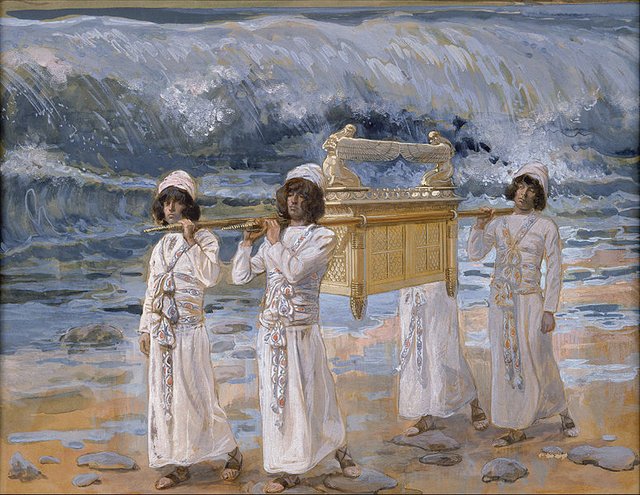
In the following chapter, Joshua himself draws a comparison between the Passage of the Yam Suph and the Passage of the Jordan (Joshua 4:23-24). But could there be any truth to this story? In an earlier article in this series—Kenneth Kitchen’s Joshua—we saw that the Biblical scholar Kenneth Kitchen was satisfied that there was.
Recently, another British scholar, the physicist Colin John Humphreys, scrutinized the “miracles” of the Exodus with the eyes of a scientist. The results of his research were documented in 2003 in the book, The Miracles of Exodus: A Scientist Reveals the Extraordinary Natural Causes Underlying the Biblical Miracles. Many of Humphreys’ explanations contradict my own account of the Exodus. For example, he identifies the Mountain of God with Hala-‘l Badr, a volcano in Midian (northwestern Arabia), which may have been active at the time. While I am willing to accept that the pillar of cloud by day and pillar of fire by night (Exodus 13;21-22) that went before the Israelites may well have been occasioned by an eruption of Hala-‘l Badr, I do not believe that the Israelites would have camped at the foot of an actively erupting volcano or that Moses would have ascended one. But what Humphreys says about the passage of the Jordan makes perfect sense to me:
The detail that caught my attention in the account of the crossing of the river Jordan is that the water stopped flowing, not where the Israelites were gathered, which one might expect if the story had been invented, but a great distance away at a town called Adam in the vicinity of Zarethan. Something had stopped the water flowing at this place called Adam. What could it have been ... (Humphreys 17)
Humphreys examined modern maps to see if he could locate Adam, noting that the original Biblical text spelt this name ’dm [אדם]:
In order to try and find ancient Adam on a modern map of the state of Jordan, I therefore looked on a map to see if there is a suitable town on the river Jordan containing the consonants dm, and indeed there is! On modern maps of the state of Jordan, a town appears on the eastern side of the river Jordan called Damiya, about seventeen miles [27 km] north of where the river Jordan passes closest to Jericho. Not only that, but on the 1989 Bartholomew World Travel Map of Israel with Jordan, the same town is actually marked Damiya (Adamah). This strongly suggests that the ancient town of Adam is modern Damiya. I was later to find that many scholars agreed on this, which is why the Bartholomew map states it. (Humphreys 19)
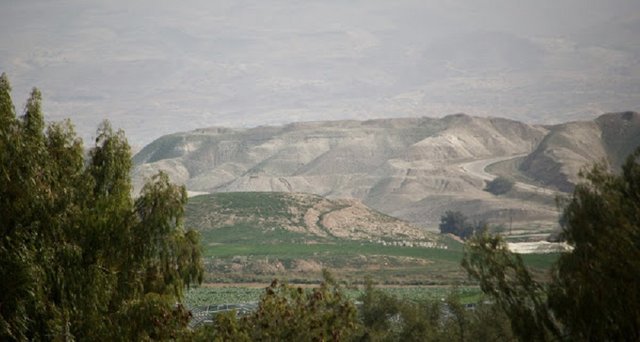
Humphreys next offers a scientific explanation for the stopping of the Jordan:
On July 11, 1927, a well-documented earthquake shook the town of Jericho, causing cracks in the buildings and panic in the local population. The earthquake was detected in seismological stations as far apart as Europe, South Africa, North America, and Russia and was measured at a magnitude of about 6.5 on the Richter Scale, which means that it was a large earthquake … Various people, including the world-renowned geophysicist Amos Nur, who is the Wayne Loel Professor of Earth Sciences and professor of geophysics at Stanford University, have made a detailed study of the 1927 Jericho earthquake and found that it was due to slippage along a geological fault called the Jericho fault, which runs approximately north-south under the Jordan River. The Jericho fault forms the boundary between two tectonic plates, with the Arabia plate to the east and the African-Sinai plate to the west. (Humphreys 19-20)
Professor Amos wrote the following to Humphreys about this earthquake:
During the 1927 earthquake, several ground cracks appeared, together with an outpouring of ground water. This soil liquefaction phenomenon has been well observed in earthquakes elsewhere. During the earthquake, mud slides occurred along the Jordan near Damia, about 30 kilometers [about eighteen miles] north of Jericho; these temporarily stopped the river’s flow. (Humphreys 20)
And this was not an isolated event:
Amos Nur then searched historical records and found that the river Jordan had been temporarily stopped on a number of occasions, all because of mud slides induced by an earthquake. The earliest historical record of this that Nur found occurred in 1160. Nur recognized the relevance of these earthquakes to the passage in the book of Joshua quoted above. He writes:
“Adam is now Damia, the site of the 1927 mud slides which cut off the flow of the Jordan. Such cut-offs, lasting typically one to two days, have also been recorded in 1906, 1834, 1546, 1534, 1267, and 1160. The stoppage of the Jordan is so typical of earthquakes in this region that little doubt can be left as to the reality of such events in Joshua’s time” [Humphreys’ italics]. (Humphreys 21)
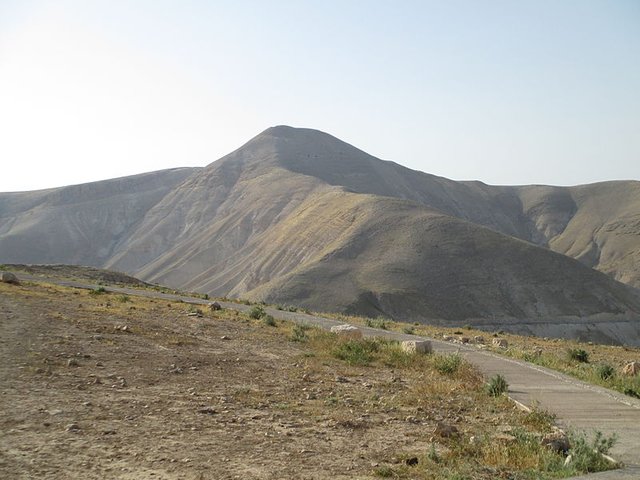
Zaretan, which is said to be beside Adam, has been identified with Mount Sartaba, where the Hasmoneans later constructed a hilltop fortress. This is about 10 km west of the modern town of Damia, and 7 km west of the River Jordan. Alternative candidates, however, have also been suggested.
If the “miraculous” passage of the Jordan was indeed occasioned by an earthquake, then this raises the intriguing possibility that the famous story of the collapse of the walls of Jericho was also induced by a natural shaking of the earth—and not by the blowing of trumpets. But that’s a story for another day.
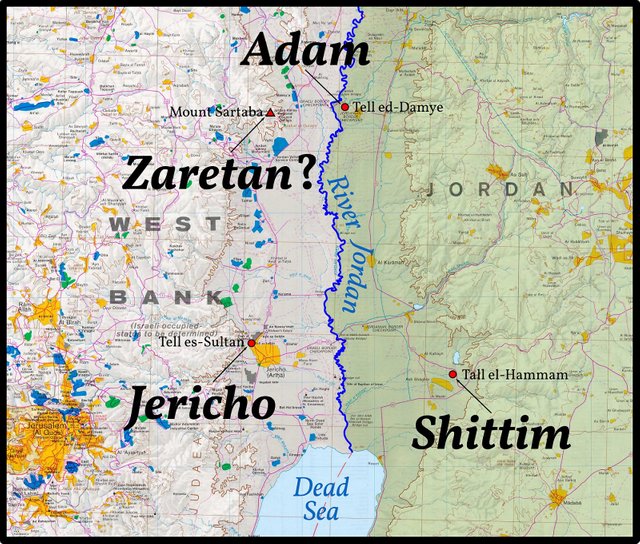
A Dissenting Opinion
It would be remiss of me not to mention the dissenting opinion of the Canadian Biblical scholar John Van Seters, who believes that many of the details in the Book of Joshua were borrowed from the literary traditions of the Neo-Assyrian Empire. Another Biblical scholar, James Hoffmeier, however, takes issue with Van Seters’ thesis:
Van Seters, for instance, believes that the motif of the Israelites crossing the Jordan during the flood stage is borrowed from reports of Sargon II and Ashurbanipal’s crossing the Tigris and Euphrates during “high water of the spring of the year.” Based on just these two texts, he asserts, “The special emphasis on the crossing can only be explained as a topos taken from the Assyrian military accounts.” Van Seters’s treatment of this matter fails on two points. First, the spring of the year was the traditional time for kings to go to war in Israel (cf. 2 Sam. 11:2) as well as in Mesopotamia. As Robert Gordon has observed, “Spring was the time for launching military campaigns, when the winter rains had stopped and the male population was not yet involved in harvesting .” Spring is also when the rivers, the Jordan as well as the Tigris and Euphrates, are at their highest levels because of melting snow from the mountains to the north. Secondly, the seemingly miraculous crossing of raging rivers by a king is well attested in earlier Near Eastern sources. Hattusili I (ca. 1650 B.C.) boasts of his accomplishments in this respect, likening them to those of Sargon the Great (ca. 2371 - 23 16 B.C.). On one occasion, Tiglath-Pileser I records that a particular crossing of the Euphrates was his twenty-eighth, and it was “the second time in one year.” It is clear that when Sargon II (721 - 705 B.C.) broadcasts his achievement, he is emulating his warrior predecessors rather than inventing a new motif. Consequently, there is no basis forVan Seters’s assertion. The river crossing in Joshua 3 by Israel’s forces accurately reflects the seasonal realities of military life in the Near East throughout the three millennia B.C. (Hoffmeier 40)
If the Short Chronology is correct, then Van Seters’ thesis fails on a third point: the so-called Neo-Assyrian Emperors were actually Persian Emperors, who lived long after Joshua’s Conquest of Canaan.
And that’s a good place to stop.
References
- Charles John Ellicott (editor), An Old Testament Commentary for English Readers, Volume 2, Cassell, Petter, Galpin & Co, Limited, London (1882)
- Robert P Gordon, I & II Samuel: A Commentary, Zondervan, Grand Rapids, MI (1986)
- James K Hoffmeier, Israel in Egypt: The Evidence for the Authenticity of the Exodus Tradition, Oxford University Press, Oxford (1996)
- Kenneth A Kitchen, On the Reliability of the Old Testament, William B Eerdmans Publishing Company, Grand Rapids MI (2003)
- Colin John Humphreys, The Miracles of Exodus: A Scientist Reveals the Extraordinary Natural Causes Underlying the Biblical Miracles, Harper Collins, London (2003)
- John Van Seters, Joshua’s Campaign of Canaan and Near Eastern Historiography, Scandinavian Journal of the Old Testament, Volume 4, Issue 2, pp 1-12, Taylor & Francis Online (1990)
Image Credits
- Joshua’s Passage of the River Jordan with the Ark of the Covenant: Benjamin West (artist), Art Gallery of New South Wales, Sydney, Google Arts and Culture, Public Domain
- The Ark Passes Over the Jordan: James Jacques Joseph Tissot (artist), Jewish Museum, New York, Public Domain
- Adam (Tell ed-Damieh): © Miguel Nicolaevsky, Fair Use
- Mount Sartaba: © Avishei Teicher, Israeli Pikiwiki Project, Creative Commons License
- Map of the Lower Jordan Valley and Environs: University of Texas Libraries, Perry-Castañeda Library Map Collection, West Bank and Vicinity, July 1992, United States Central Intelligence Agency, Public Domain
